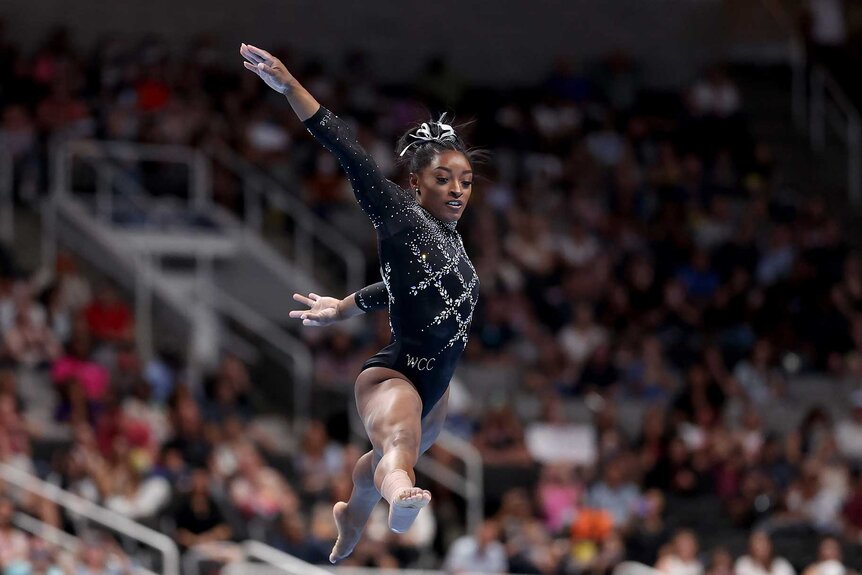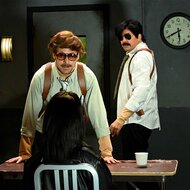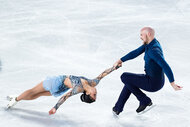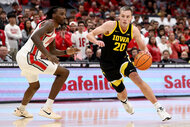What Are the Twisties in Gymnastics?
This dangerous mental roadblock sidelined Simone Biles at the Tokyo Olympics in 2021.

The gymnastics term “twisties” may seem innocuous, but the dangerous roadblock has derailed some of gymnastics’ fiercest competitors, including Olympic champion Simone Biles.
Biles was forced to pull out of the team all-around final and individual competition at the Tokyo Olympics due to the twisties—which some gymnasts have compared to skydiving without a parachute or having a nonserious stroke mid-air.
“It’s the craziest feeling ever,” Biles said at the time, according to NBC News, adding that she “literally can not tell up from down” while suffering from the debilitating affliction.
What Are the Twisties?
So, just what are the twisties? The twisties are a phenomenon that causes gymnasts to lose their sense of space and dimension mid-air.
RELATED: Everything to Know About the U.S. Gymnastics Olympic Trials: "Got to See It to Believe It"
Even if it’s a maneuver that a gymnast has successfully performed hundreds of times, suddenly their brain feels disconnected from their body.
“The rhythm is off, and your brain will like stutter step for half a second and that's enough to throw off the whole skill,” 2016 Olympic champion gymnast Laurie Hernandez explained to Olympics.com. “And, so, it happens, and it takes a second to get over that.”
The mental roadblock can often appear under extreme stress or when gymnasts are performing high-level skills, creating a dangerous scenario for a competitor.
“I had no idea where I was in the air,” Biles explained to The Washington Post. “I could have hurt myself.”
What Have Gymnasts Said About the Twisties?
After suffering a bout of the twisties, British gymnast Claudia Fragapane miscalculated during an Olympic qualifying event in 2021 and found herself trying to do a double somersault instead of a single. She fell and landed on her head and neck, leaving her with a concussion.
"It's really dangerous if you doubt yourself a little bit, or you find it really hard, you can really really hurt yourself,” she told the BBC.
RELATED: Simone Biles' Family Reacts To Her Making History at U.S. Championships
Christina Myers, a former gymnast turned coach in Alabama, described the twisties to the news outlet as a total disconnect between the brain and body.
"Imagine skydiving and your parachute won't open," she said. "Your body starts adding extra twists and flips to the skill you're supposed to be doing, and it can affect even the skills that feel as routine as walking to an elite gymnast.”
Missy Marlowe, an Olympian in 1988, wrote on X after Biles stepped back from competition in Tokyo that having the twisties was comparable to a “nonserious stroke.”
“You cannot fix it quickly—can take months, if at all,” she wrote.
Myers added that because the roadblock is “mainly psychological” the harder you try to push through it the more debilitating it can be.
How Do You Cure the Twisties?
So, just how do gymnasts work through the twisties? It can take time and a return to the basics.
Former elite gymnast Sean Melton told The Washington Post that when he encountered the twisties early in his career his coaches would have him go back to working on basic elements like a back tuck or back layout before slowly working up to more complex skills.
Gymnasts may also add in another safety mechanism into their routine like performing a skill into a foam pit to reduce the risk of injury— but the tool may not be available at a high-level competition.
"They have very limited equipment and mats in Tokyo to help something like this get fixed, let alone with in a day," former U.S. national team member Aleah Finnegan said, according to Olympics.com. "You have absolutely no control over your body and what it does. The more you psych yourself [out] about it, the worse it becomes."
Taking a step back and reducing the mental stress placed on a competitor can also help the athlete work through the twisties and return to their usual level of performance.

















